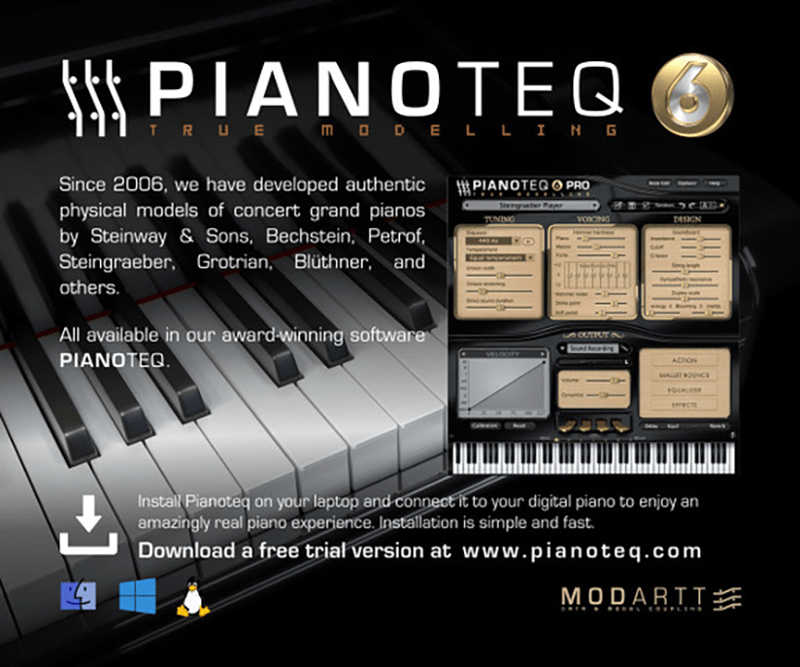The obvious question: If you already have a digital piano, why would you want to add a software piano? Most digital pianos are capable of producing more than one piano sound, but typically, all of these sounds are based on a single piano as a sample source. Think of it this way: If you could add a Bösendorfer, Blüthner, Fazioli, or Steinway to your palette of piano samples for only the cost of the software, would you do it? (I hear the sounds of pianos and computers being pushed together even now.) How about being able to virtually design your own instrument with piano software based on physical modeling? (Physical modeling is the use of mathematical algorithms to mimic the acoustic properties of piano sounds.)

Adding a software piano to your existing piano, or building your own piano from a "piano kit," is a bit more involved than putting your computer and your piano in the same room — but not by much. Let's take a look at the requirements on both the computer and piano sides. Since the requirements for the piano are pretty simple, we'll start there.
Digital and Hybrid Piano Considerations
If your existing piano is going to serve as the basis for your extended piano family, the minimum requirement is that it have MIDI-out capability — USB MIDI makes it slightly easier, but regular MIDI connections will do as well. The good news here is that all currently available digital pianos and most acoustic hybrid pianos already have, or can add, this capability. The next step is to be able to get your existing "host" piano to stop producing its own sound. For digital pianos, this consists of a brief trip to the owner's manual to learn how to set it up as a "controller" or "master" keyboard. Acoustic pianos must either be capable of "silent" mode or must be converted to enable it (see "Hybrid Pianos" in this issue).
Computer Considerations
Requirements for the computer vary considerably, depending on the piano software used and the choices you make in software settings. Just as with digital pianos, sample-based software is highly dependent on the size of the computer's memory, while physical modeling software — which creates the sound in real time rather than retrieving an existing sound sample — primarily depends on the speed of the computer's processor. At a minimum, hardware requirements will involve processor type and speed, and the amount of random-access memory (RAM) and hard-disk space. These requirements range from packages that can run on most recent-vintage mid-range computers, to those requiring higher-speed multi-core processors, 8 Gigabytes (GB) of RAM, over 250 GB of free hard-disk space (preferably on a fast SSD drive), and a dedicated sound card. Either way, you need to check the hardware requirements of the individual software package you'd like to run to make sure it will work properly on your computer — or use it as an excuse to get a new computer.
Aside from making sure that you have enough memory to store and run these packages, processor and sound-card choices will also keep latency in check. Latency is how long it takes the computer to produce a sound from the time you press a key. When latency becomes noticeable, your brain doesn't know whether to slow your playing so that the sound can catch up, or to speed up to make the sound happen faster. Neither of these works. (Anyone who plays the pipe organ knows what latency is, and will adapt to it without a second thought.)
Software
This is where the real fun starts. There are currently dozens of software-piano packages available, at prices ranging from under $50 to over $500. These include both sample-based packages and packages based on physical modeling. There are products on the market for Mac, PC, and even mobile-device platforms. Several host acoustic pianos (i.e., the sources of the samples) are available via software, including instruments made by Bechstein, Bösendorfer, Blüthner, Fazioli, Kawai, Steingraeber, Steinway, and Yamaha. If you'd like to add some period instruments to your palette, there are also packages with samples from historical fortepianos.
If you're not particularly into computers, software pianos may not be for you. But if you enjoy even a mild bit of tinkering, and have dreamed of owning a collection of the world's finest pianos or even of "designing" your own piano, you may find software pianos an irresistible temptation. If you're interested in following the world of piano software, it's discussed in Piano World's "Digital Pianos — Synths & Keyboards" forum.